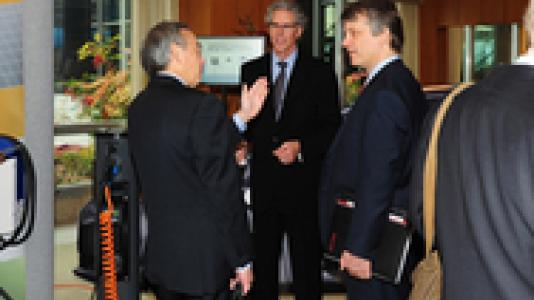
Argonne will host one of two Electric Vehicle-Smart Grid Interoperability Centers being established by U.S. Department of Energy (DOE) and the European Commission’s (EC) Joint Research Centre to facilitate transatlantic interoperability between electric vehicles (EVs) and the charging infrastructure.
Interoperability is the capability of a system component to work with other products or systems without any restricted access or implementation. For electric vehicles and EVSEs (electric vehicle supply equipment or charge stations), interoperability means meeting standards for connectivity and communication to ensure that all plug-in vehicles can charge using any EVSE and that the vehicle and/or EVSE can communicate to the utility or grid operator to enable billing or more sophisticated interactions, such as two-way communication and load management. Global standardization would allow seamless operation of vehicles and EVSEs across borders and service areas of different utilities. Specifically, this means ensuring that messages and protocols are compatible between the utilities/grid operators, home or workplace communication networks, EVSEs and electric/plug-in hybrid vehicles.
U.S. Assistant Secretary for Policy and International Affairs David Sandalow and Europe’s EC Joint Research Centre Director-General Dominique Ristori signed a Letter of Intent on November 28 to establish similar facilities to support development and testing of vehicle-grid interface technologies, support data-driven standards refinement and development, and undertake projects to enhance the interoperability of electric vehicles, electric vehicle supply equipment and smart grids. The expected benefits of harmonizing standards and verifying interoperability are lower engineering, development and manufacturing costs; increased manufacturer/supplier confidence, reduced time to market for electric vehicles; and increased consumer confidence (charge any vehicle, with any charger,anywhere).
During the signing event, Sandalow and Ristori viewed a DOE display explaining electric vehicle smart grid and interoperability issues. Argonne researchers Keith Hardy and Jason Harper, as well as DOE Secretary Chu were on hand to talk to EU representatives about advanced vehicle technologies and smart grid implementation.
Next steps after the signing include:
- Establish the DOE Electric Vehicle-Smart Grid Interoperability Center at Argonne, since it has interoperability test fixtures (SAE J2931), end-use measurement and communication technology development underway;
- Develop a functional specification for the laboratories and identify potential EC laboratories; and
- Form a joint EU-US technical team to define the scope, refine the facility specifications and establish joint operating procedures (including industry participation).